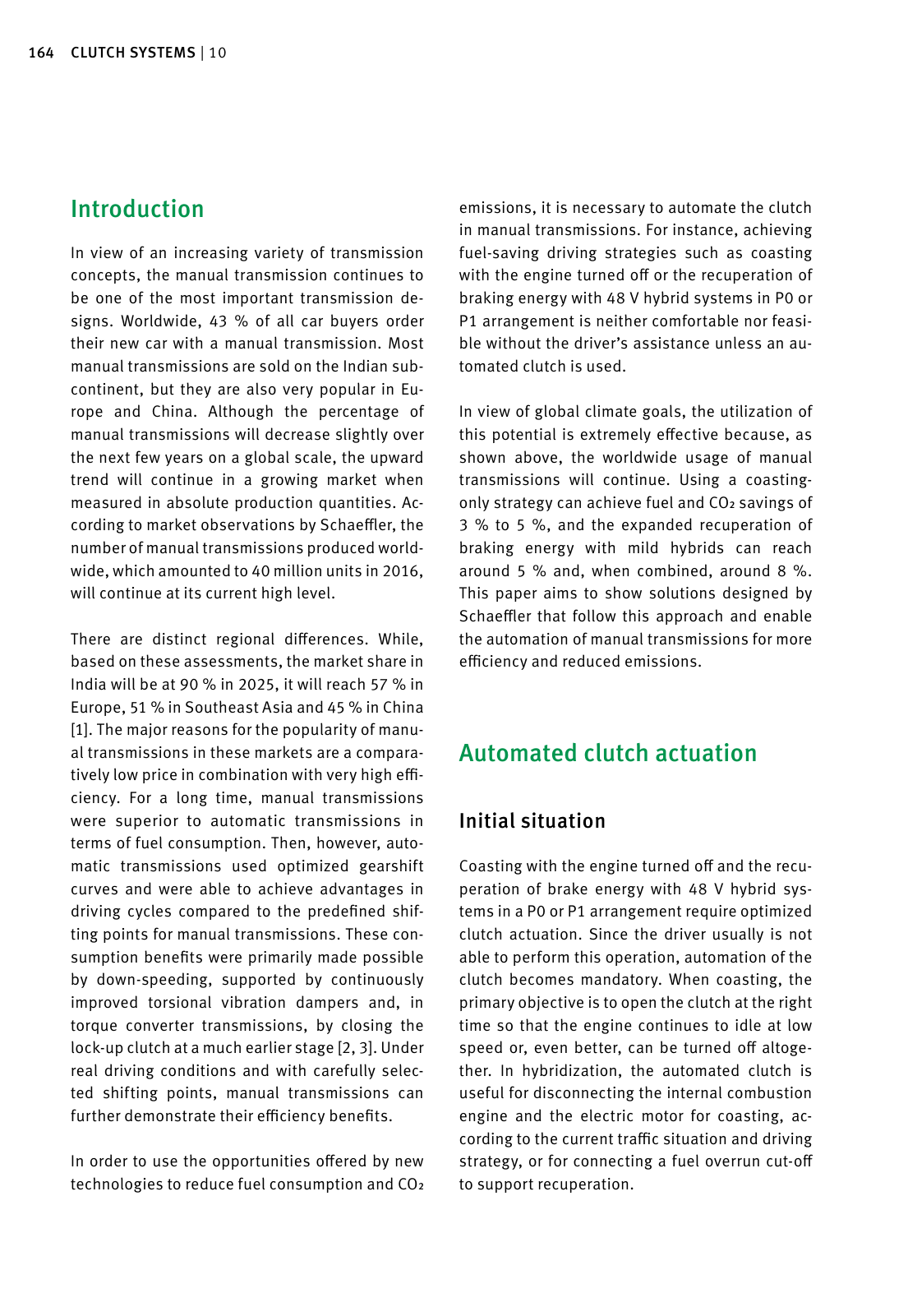164 CLUTCH S Y STEMS 10 16510 CLUTCH S Y STEMSSchaeffler Symposium 2018 An automated clutch can also be used to imple ment additional functions in a simple way For in stance it permits extended assistance functions such as the traffic jam assist that carries out starts and stops in slow moving traffic on the in terstate Other functions are the protection of the clutch and the powertrain from excessive loads such as in case of misuse and the increased safe ty of vehicles and passengers One example here is the automatic opening of the clutch when the assistance system initiates an emergency brake application to prevent the engine from stalling Implementation variants of the automated clutch Three implementation variants of the E Clutch are described below each of them different with re gard to available or missing clutch pedals as well as with regard to the degree of automation Figure 1 This includes the partly automated and low Introduction In view of an increasing variety of transmission concepts the manual transmission continues to be one of the most important transmission de signs Worldwide 43 of all car buyers order their new car with a manual transmission Most manual transmissions are sold on the Indian sub continent but they are also very popular in Eu rope and China Although the percentage of manual transmissions will decrease slightly over the next few years on a global scale the upward trend will continue in a growing market when measured in absolute production quantities Ac cording to market observations by Schaeffler the number of manual transmissions produced world wide which amounted to 40 million units in 2016 will continue at its current high level There are distinct regional differences While based on these assessments the market share in India will be at 90 in 2025 it will reach 57 in Europe 51 in Southeast Asia and 45 in China 1 The major reasons for the popularity of manu al transmissions in these markets are a compara tively low price in combination with very high effi ciency For a long time manual transmissions were superior to automatic transmissions in terms of fuel consumption Then however auto matic transmissions used optimized gearshift curves and were able to achieve advantages in driving cycles compared to the predefined shif ting points for manual transmissions These con sumption benefits were primarily made possible by down speeding supported by continuously improved torsional vibration dampers and in torque converter transmissions by closing the lock up clutch at a much earlier stage 2 3 Under real driving conditions and with carefully selec ted shifting points manual transmissions can further demonstrate their efficiency benefits In order to use the opportunities offered by new technologies to reduce fuel consumption and CO2 emissions it is necessary to automate the clutch in manual transmissions For instance achieving fuel saving driving strategies such as coasting with the engine turned off or the recuperation of braking energy with 48 V hybrid systems in P0 or P1 arrangement is neither comfortable nor feasi ble without the driver s assistance unless an au tomated clutch is used In view of global climate goals the utilization of this potential is extremely effective because as shown above the worldwide usage of manual transmissions will continue Using a coasting only strategy can achieve fuel and CO2 savings of 3 to 5 and the expanded recuperation of braking energy with mild hybrids can reach around 5 and when combined around 8 This paper aims to show solutions designed by Schaeffler that follow this approach and enable the automation of manual transmissions for more efficiency and reduced emissions Automated clutch actuation Initial situation Coasting with the engine turned off and the recu peration of brake energy with 48 V hybrid sys tems in a P0 or P1 arrangement require optimized clutch actuation Since the driver usually is not able to perform this operation automation of the clutch becomes mandatory When coasting the primary objective is to open the clutch at the right time so that the engine continues to idle at low speed or even better can be turned off altoge ther In hybridization the automated clutch is useful for disconnecting the internal combustion engine and the electric motor for coasting ac cording to the current traffic situation and driving strategy or for connecting a fuel overrun cut off to support recuperation cost MTplus solution Clutch by Wire CbW sys tems with a clutch pedal emulator as well as elec tronic clutch management ECM systems that can do entirely without a clutch pedal MTplus is an entry level system for the partial au tomation of the clutch that is below the technical level required for CbW and ECM systems 3 An actuator with a suitable design is used in addi tion to the existing master cylinder on the clutch pedal This actuator whose functional principle is described in more detail in the following chap ter has a time interval of 300 ms to open the clutch providing sufficient dynamics for the ba sic function of entering and exiting the coasting mode One challenge was to find an actuator con cept that would permit conventional and auto mated clutch actuation at the same time This is because on the one hand the actuator must not interfere with normal foot actuation and on the other hand the driver must be in control at all times MTplus CbW MTplus actuator Hydrostatic or mechanical MCA ECM CbW Clutch by Wire ECM Electronic Clutch Management Sailing Efficiency Comfort Fun to Drive Robustness Safety 1 Variants for clutch automation MTplus Clutch by Wire CbW and Electronic Clutch Management ECM

Hinweis: Dies ist eine maschinenlesbare No-Flash Ansicht.
Klicken Sie hier um zur Online-Version zu gelangen.
Klicken Sie hier um zur Online-Version zu gelangen.